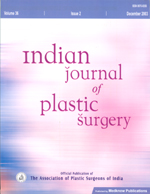
|
Indian Journal of Plastic Surgery
Medknow Publications on behalf of Indian Journal of Plastic Surgery
ISSN: 0970-0358
EISSN: 0970-0358
Vol. 42, No. S1, 2009, pp. 19-34
|
 Bioline Code: pl09076
Bioline Code: pl09076
Full paper language: English
Document type: Review Article
Document available free of charge
|
|
|
Indian Journal of Plastic Surgery, Vol. 42, No. S1, 2009, pp. 19-34
| en |
Neuroembryology and functional anatomy of craniofacial clefts
Ewings, Ember L. & Carstens, Michael H.
Abstract
The master plan of all vertebrate embryos is based on neuroanatomy. The embryo can be anatomically divided into discrete units called neuromeres so that each carries unique genetic traits. Embryonic neural crest cells arising from each neuromere induce development of nerves and concomitant arteries and support the development of specific craniofacial tissues or developmental fields. Fields are assembled upon each other in a programmed spatiotemporal order. Abnormalities in one field can affect the shape and position of developing adjacent fields. Craniofacial clefts represent states of excess or deficiency within and between specific developmental fields. The neuromeric organization of the embryo is the common denominator for understanding normal anatomy and pathology of the head and neck. Tessier′s observational cleft classification system can be redefined using neuroanatomic embryology. Reassessment of Tessier′s empiric observations demonstrates a more rational rearrangement of cleft zones, particularly near the midline. Neuromeric theory is also a means to understand and define other common craniofacial problems. Cleft palate, encephaloceles, craniosynostosis and cranial base defects may be analyzed in the same way.
Keywords
Cleft; Embryology; Tessier
|
| |
© Copyright 2009 Indian Journal of Plastic Surgery.
Alternative site location: http://www.ijps.org/
|
|
